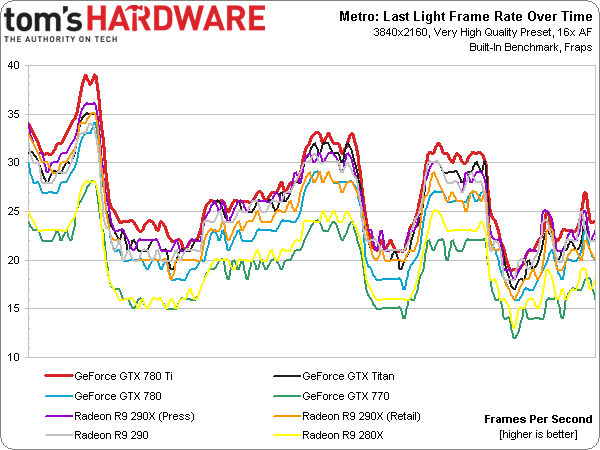Nvidia GeForce GTX 780 Ti Review: GK110, Fully Unlocked
Hot on the heels of AMD's Radeon R9 290X receiving acclaim for a fair price and high performance, Nvidia is launching its fastest single-GPU gaming card ever: GeForce GTX 780 Ti. It's quicker than 290X, but also more expensive. Is the premium worthwhile?
Results: Metro: Last Light
At every resolution, GeForce GTX 780 Ti is the fastest single-GPU graphics card you can buy. Granted, that distinction isn’t uncontestable—it’s only a couple of frames up on AMD’s Radeon R9 290X press board with its higher 40% fan speed, and could easily be challenged by a third-party board with better cooling. However, our retail card shows us that when Hawaii heats up and cannot be cooled fast enough, 780 Ti could be up to 22% faster at 2560x1440 as 290X drops below the performance levels of a vanilla GeForce GTX 780.
Bumping up fan speed on the AMD card is going to help that. However, then you’re also messing with acoustics, and noise can be a big issue with the reference cooler, too.
I personally think the average frame rate chart is more telling than any of the frame rate over time graphics, if only because the spread between boards appears so tight. It is worth pointing out that the GeForce GTX 780 Ti doesn’t drop below 30 FPS at 2560x1440, while our retail R9 290X does flirt with this boundary.
These are the same frame time variance outliers observed in our Radeon R9 290 coverage. We have four different GPUs with varying memory configurations represented, so it’s unlikely that any one variable is to blame. More than likely, if we were to zoom in to 96th or 97th percentile numbers, similar worst-case conditions would crop up for the other cards, too.
Get Tom's Hardware's best news and in-depth reviews, straight to your inbox.
Current page: Results: Metro: Last Light
Prev Page Results: Crysis 3 Next Page Results: The Elder Scrolls V: Skyrim-
faster23rd My heart broke a little bit for AMD. Unless AMD's got something up their sleeve, it's up to the board manufacturers now to get the 290X in a better competitive stance than the 780 ti.Reply -
tomc100 At $700, AMD has nothing to worry about other than the minority of enthusiast who are willing to pay $200 more for the absolute fastest. Also, when games like Battlefield 4 uses mantle the performance gains will be eroded or wiped out.Reply -
expl0itfinder Keep up the competition. Performance per dollar is the name of the game, and the consumers are thriving in it right now.Reply -
alterecho I want to see cooler as efficient as the 780 ti, on the 290X, and the benchmarks be run again. Something tells me 290X will perform similar or greater than 780ti, in that situation.Reply -
ohim Price vs way too few more fps than the rival will say a lot no matter who gets the crown, but can`t wonder to imagine the look on the face of the guys who got Titans for only few months of "fps supremacy" at insane price tags :)Reply -
bjaminnyc 2x R9 290's for $100 more will destroy the 780Ti. I don't really see where this logically fits in a competitively priced environment. Nice card, silly price point.Reply -
Innocent_Bystander-1312890 "Hawaii-based boards delivering frame rates separated by double-digit percentages, the real point is that this behavior is designed into the Radeon R9 290X. "Reply
It could also come down to production variance between the chips. Seen in before in manufacturing and it's not pretty. Sounds like we're starting to hit the ceiling with these GPUs... Makes me wonder what architectural magic they'll come up with next.
IB -
bjaminnyc 2x R9 290's for $100 more will destroy the 780Ti. I don't really see where this logically fits in a competitively priced environment. Nice card, silly price point.Reply -
Deus Gladiorum I'm going to build a rig for a friend and was planning on getting him the R9 290, but after the R9 290 review I'm quite hesitant. How can we know how the retail version of that card performs? Any chance you guys could pick one up and test it out? Furthermore, how can we know Nvidia isn't pulling the same trick: i.e. giving a press card that performs way above the retail version?Reply





